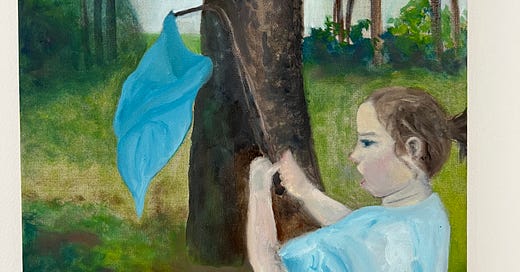Since my daughter was a baby I have been looking for a patch of grass to give her, for her to play with sticks and make mud pie. It is surprisingly hard to find in New York, a city of glass and concrete. Finally earlier this week, we made it to Central Park, where the cherry blossom trees are in full bloom. There are some daffodils, about to wilt. The magnolias have lost their petals already. And my daughter played with soil and water and ran with a makeshift kite. I felt torn about taking time away from the studio, but I am so glad we shared this moment together. And when I went back to work, I made a painting of her, no longer a toddler but a child flying her own flag.
I just read Christine Angot’s new essay on spending a night at La Bourse, François Pinault’s collection in Paris. The French publishing house Stock publishes a series of texts in which an author is invited to spend a night at a museum of their choosing wherever they fancy in the world.
Spending a night in a museum has been a dream of mine since I was a kid and my parents took me along to an opening of their friend the sculptor Alain Kirili at the Museum of Grenoble. While the grown-ups were eating, Alain’s nephew and I, we must have been about nine or ten, slipped out to the unattended rooms nearby. I remember the thrill of doing something forbidden and seeing the Ancient Egyptian artefacts in the half lit rooms at night.
Christine Angot’s book is a denunciation of the vanities of the French contemporary art world - who owns the power, who owns the money. Sophie Calle, Jean-Michel Othoniel, Perrotin, everyone makes an unflattering appearance as Angot watches them from a distance, never fully belonging in their midst. She writes about the violence of feeling like an outsider, having no money, no power at first, having been erased by the will of a father who committed the worst. This night that she is scheduled to spend in an intimidating, closed off space orchestrated by an omnipotent man, France’s most powerful collector, becomes in her mind tainted with the nights where she had to acquiesce to the demands of a father who raped her repeatedly. The only way she can go through this night she has been requested to spend in the museum is by dissociating from the space, in the end she doesn't even see the collection, she is blind to the artworks that surround her. But she finds salvation by bringing her daughter, an art student. Instead of it being a place of transmission from a parent to a child, as can often be the case in a museum, the museum turned into a bedroom becomes a space where the mother listens, she asks her daughter to tell her what she sees. Instead of looking at the artworks, some of them by the most important or prominent artists of late (Félix Gonzáles-Torres, Roni Horn, Maurizio Cattelan to name but a few), she looks at her daughter. Instead of making the works speak for the readers, she listens to her daughter. Instead of spending the night in the museum, she shuts off her computer and leaves at 1 A.M to the dismay of the guard who had set up a desk for her to write at and a camp bed.
In this eloquent short text what Angot does is dismiss art and power to focus on the soothing and even redemptive power of watching one’s daughter grow into her own independent being. She cannot and will not look at the art around her, but she sees her daughter take it in and that is enough for her. It is not a book about the gaze of the collector, the critic or the visitor, it is a book about the gaze and the blindspots of a mother.
READ
Christine Angot, La nuit sur commande
SEE
La Bourse du commerce - Free on May 17th for European Night of Museums




